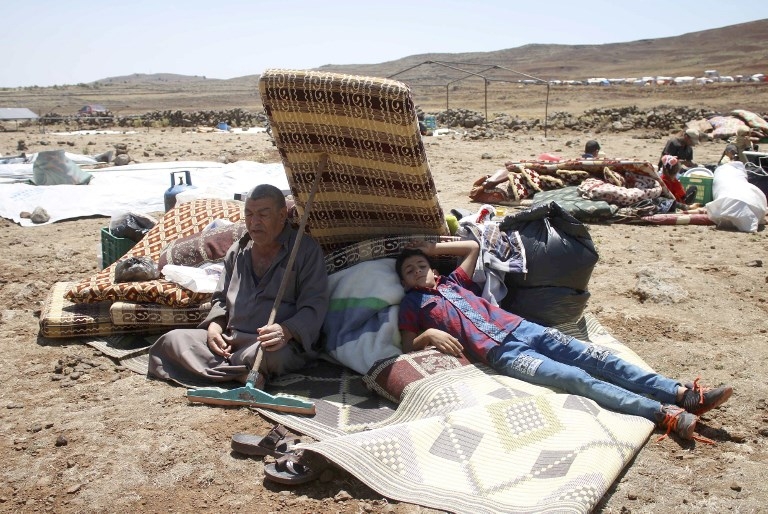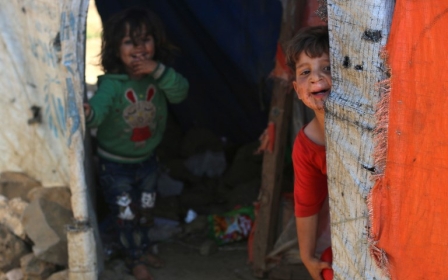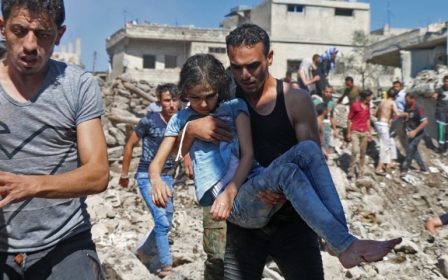Civilians in limbo after fleeing southern Syria ‘death triangle’

Al-AWDEH CAMP, Jordan - Mohammad Ghani, his wife, mother and four children left the village of Um al-Osaj in southern Syria’s Daraa province on Tuesday in the middle of the night.
The 35-year-old Syrian farmer and his family were forced to flee their home as Syrian government aircraft, supported by Russian jets, rained bombs down on the village as part of a campaign stepped up since 19 June.
At least 98 Syrian civilians have been killed in the Daraa governorate over 10 days of fighting, according to UK-based monitoring group Syrian Observatory for Human Rights. Scores of pro-government troops and anti-Assad fighters have also died in clashes.
Meanwhile, tens of thousands of people have fled the fighting, amid fears that the Daraa battle could have devastating and long-lasting repercussions on civilians.
The Ghani family’s village, Um al-Osaj, lies in what is known as the “Triangle of Death”, the point where the countrysides of Daraa, Damascus and Quneitra convene.
“We were living in a comfortable big home; our children would play, and I would plant vegetables,” Ghani told Middle East Eye.
“Now we are stuck in a tiny tent suffering under the hot sun, with all kinds of mosquitoes, snakes and other inconveniences. Our only source of food is what the World Food Programme is giving us” - a basket that he said contained bare essentials such as rice, flour, oil, and baby formula.
We ask God that salvation from this will happen soon
- Mohammad Ghani, displaced Syrian farmer
“Initially we had no idea where to go until someone directed us to the refugee camp near the occupied Golan Heights,” Ghani added. “When we arrived, the camp director, Abu Karam, took us in to his own dwelling until we would find our own tent.”
The newly internally displaced Syrian man said has no idea where he might be headed next.
“We ask God that salvation from this will happen soon,” was all he could say.
The Ghani family is staying in al-Awdeh, one of several camps in the Quneitra area. The camp was initially set up in 2013 by people fleeing the violence in different parts of Syria, and today is home to more than 3,000 people, mostly from Damascus and Homs area villages.
Abu Karam, the director of al-Awdeh camp, told MEE that it was the largest of a series of camps that include Bir Ajam, Akash and Ahla al-Kheir.
The Quneitra-area camps are located in a strip of land connecting Syria with the Golan Heights under the control of the Free Syrian Army. The UN established the area as a buffer zone in 1973 after attempts by the Syrian army to regain control of its lands occupied by Israel since 1967.
“These camps are now part of a series of dwellings that house people who have fled the triangle of death, which many expect to be taken by the Syrian regime soon," Abu Karam said.
Abu Bakr al-Hassan, a military commander of Jaish al-Thawra rebel group in Daraa, told MEE that some 2,000 families have fled from the villages of al-Hara, al-Teha, Kufr Nasej, Juthor and Nawa since 19 June towards somewhat calmer areas near the border with Jordan and the Israeli-occupied Golan Heights.
But Hassan is concerned that a humanitarian crisis is looming: “We are expecting a large increase in refugees and we have a shortage of tents, food and medicine to absorb large numbers of incoming refugees.”
Jordan keeps border closed
The risk of a crisis is compounded by the fact that Jordan has announced it would not take in more Syrians.
Jordan, which hosts 650,000 registered refugees, says that the overall Syrian refugee population in the country since 2011 is 1.3 million.
Jordan closed its Nassif commercial and passenger border crossing with Syria in April 2015. At the time, the closure was justified by Jordan due to “violence on the other side of the border crossing”.
All crossing points between Jordan and Syria have since been closed after a June 2016 incident in the Rukban refugee camp on the Syrian side, in which seven Jordanian border patrol officers were killed as a result of a suicide car attack.
Jordan says that the Rukban camp has become a haven for IS fighters and that it is “not a Jordanian responsibility”.
Juman Ghneimat, a spokesperson for the Jordanian government, insisted in an interview with MEE that Jordan could not take responsibility for the escalation in violence.
“What is happening now is a sharp increase in violence in South Syria and we simply can’t take any more refugees,” Ghneimat said. “The international community must work to stop this deterioration and deal with the results of this violent upsurge.”
Ghneimat argued that Jordan had done its duty towards its Syrian neighbours: “We have born more than we can take in dealing with the Syrian refugees and providing for them. We simply can’t take the responsibility for any more at a time when the international community is not helping Jordan cover its own plans to accommodate those already in our midst.”
'Open the borders'
Many of the country's citizens appear to disagree with their government's stance, however, with a call to "open the borders" becoming the top trending topic among Jordanian Twitter users.
International humanitarian organisations are worried that a new ad hoc camp will appear near the border with Daraa - much like Rukban did.
Rukban camp was established in 2016 when people fleeing the Islamic State group in eastern Syria set up camp in the border area between Syria and Jordan on a stretch of seven kilometres long and three-kilometres wide.
Norwegian Refugee Centre coordinator Elias Abu Atta told MEE that more was needed to avoid disaster.
“We are concerned that a repeat of the Rukban scenario will occur if Jordanian authorities continue to insist not to allow any more refugees to enter and move to the Azraq camp, which can absorb 80,000 more refugees,” he said.
“The areas refugees are fleeing to today can’t absorb them, because they have dangerously low supplies of food and energy. The building and tents are overcrowded, which means that people are sleeping in the open air.”
‘We have to be ready'
The UN High Commission on Refugees has announced that more than 120,000 Syrians are now internally displaced by the fighting in Daraa, many of whom are in areas close to the Jordanian border.
“At the present time, there aren’t a lot of people near the earth wall that borders Syria with Jordan,” UNHCR spokesman Mohammad Hawari told MEE. “But we are preparing ourselves for some 60,000 Syrians who will arrive from east and west by preparing food supplies and blankets.”
There will be a large wave of people because of the insistence on the fighters to battle it out and reject any political agreement
- Mamoun Abu Nawwar, retired Jordanian army major general
Hawari said UNHCR has shifted money and stopped some of its current programmes in Jordan to prepare to meet the needs of the potential new refugees and displaced people.
“We have to be ready to save people from real danger that might occur to them because of this emergency.”
The current explosive situation in south Syria happens after the collapse of a three-party agreement reached in Amman in 2017. At the time, Jordan, the US and Russia announced that rebel fighters “will not be supported if they attacked the regime.”
Mamoun Abu Nawwar, a retired Jordanian army major general, expects that a humanitarian crisis will take place in the south of Syria.
“There will be a large wave of people because of the insistence on the fighters to battle it out and reject any political agreement,” he said. “Jordan should have sought guarantees of setting up a safe zone for refugees in case the current low-intensity agreement collapses.”
Abu Nawwar expects that the “opposition fighters will not last a long time in face of the onslaught of the Syrian regime and its air force. They will try to pressure Israel and Jordan to accept refugees fleeing their homes.”
The retired army official said, however, that Jordan was keen to lead an effort for political reconciliation between the rebel fighters on the one hand and the regime and Russia on the other - although Syrians like Mohammed Ghani and his family will be left in limbo until then.
New MEE newsletter: Jerusalem Dispatch
Sign up to get the latest insights and analysis on Israel-Palestine, alongside Turkey Unpacked and other MEE newsletters
Middle East Eye delivers independent and unrivalled coverage and analysis of the Middle East, North Africa and beyond. To learn more about republishing this content and the associated fees, please fill out this form. More about MEE can be found here.





